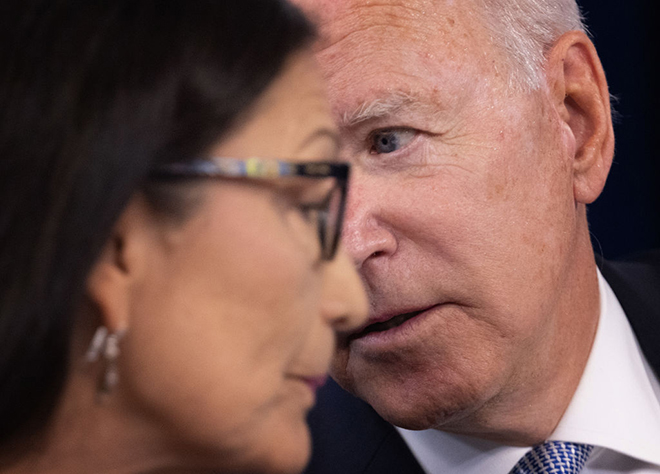S&P Global Offerings
Featured Topics
Featured Products
Events
S&P Global Offerings
Featured Topics
Featured Products
Events
S&P Global Offerings
Featured Topics
Featured Products
Events
Banking & Capital Markets
Economy & Finance
Energy Transition & Sustainability
Technology & Innovation
Podcasts & Newsletters
Banking & Capital Markets
Economy & Finance
Energy Transition & Sustainability
Technology & Innovation
Podcasts & Newsletters
S&P Global Offerings
Featured Topics
Featured Products
Events
7 Jul, 2021
By J. Holzman

|
U.S. President Joe Biden confers with U.S. Interior Department Secretary Deb Haaland during an event with governors of Western states and cabinet members June 30, 2021, in Washington, D.C. Haaland previously cosponsored legislation that would have removed uranium from the federal list of critical minerals. |
The leading U.S. minerals science agency said uranium is not qualified for inclusion on the federal list of commodities essential to national and economic security, though the agency did not state whether it should be removed from that list.
The Critical Minerals List is a record of which minerals the U.S. government considers essential to its security. Created under the Trump administration, the list has been cited in policy actions focused on permitting, grant funding and research and development. Congress passed pandemic stimulus legislation in December 2020 that required the U.S. Geological Survey, which oversees the list, to update it at least every three years and add or subtract minerals from the list.
Uranium was initially included on a 2018 list of critical minerals published under the Trump administration by the U.S. Interior Department, which oversees USGS.
In a previously unreported document released May 7, scientists at the U.S. Geological Survey recommended that nickel and zinc be added to the list and called for the removal of four materials: helium, potash, rhenium and strontium. The scientists also said uranium was excluded for consideration as a critical mineral under language in the stimulus law barring fuel minerals, like petroleum and natural gas, from being reviewed for the list.
They did not make a formal recommendation regarding whether uranium should be on the list, instead excluding it outright from its analysis. "[A]lthough uranium has important nonfuel uses, its formal definition as a fuel mineral excludes it from consideration here," the report stated.
Shift in view
After the 2011 Fukushima nuclear disaster, the price of uranium plummeted, and domestic uranium miners found it difficult to keep mines operating. The U.S. nuclear fleet largely relied on nuclear fuel created through processing uranium from other countries, predominantly Canada and Kazakhstan.
Government officials under the Trump administration cited uranium's placement on the list and the diminished state of U.S. uranium miners to justify a host of actions intended to support expanded uranium production, including a probe into the impacts of uranium imports and an announcement it would give clean energy loans to certain uranium processing and refining projects. These efforts culminated in the enactment of a federal domestic uranium purchasing program.
But environmental advocates asserted that the move was a Trojan horse intended to lay a policy rationale for allowing more uranium mining, including near the Grand Canyon. Democratic lawmakers, including current Interior Department Secretary Deb Haaland, then made an unsuccessful push to remove uranium from the critical minerals list through legislation.
One of the environmental advocacy groups that lobbied against including uranium on the list, Earthworks, is optimistic the Biden administration will remove uranium from the list based not only on the new methodology but also on its discussions with Biden administration officials. In an interview, Earthworks senior policy counsel Aaron Mintzes said officials at the U.S. Energy and Interior Departments privately conveyed the view that they "think of uranium as a fuel mineral."
"We've heard a shift in view from the previous administration from thinking of uranium as a critical mineral to thinking of uranium as a fuel mineral," Mintzes said.
'Pre-final' list
When reached for comment, USGS spokesperson Alex Demas said in an email that the decision not to review uranium was based on a literal reading of the pandemic stimulus law passed in December. The agency did not make a recommendation "for or against" including uranium on the critical minerals list, Demas said.
"[W]e did not evaluate uranium at all and have provided no recommendation for uranium's inclusion or exclusion within the Critical Minerals List," Demas said.
Commodities that were on the initial list published under the Trump administration but that did not meet the criteria for inclusion on a new list will be determined through an interagency process, according to USGS. The interagency review includes input from the National Science & Technology Council's Critical Minerals Subcommittee, a policy group made up of representatives from various federal agencies.
The interagency review is currently ongoing, and once comments from other agencies have been "appropriately addressed," the Interior Department will publish a "pre-final" list of critical minerals for public comment, Interior spokesperson Melissa Schwartz said in a July 6 email. The list will not be finalized until after public comments have been "reviewed and addressed."
"The USGS methodology is helpful in deciding which minerals qualify as critical, but is only one of the steps in the process," Schwartz said.
